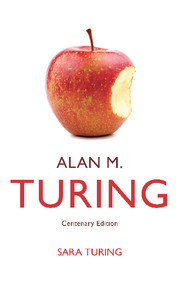Book contents
- Frontmatter
- Contents
- Foreword to the Centenary Edition
- Preface to the First Edition
- Foreword to the First Edition
- Part One Mainly Biographical
- 1 Family Background
- 2 Childhood and Early Boyhood
- 3 At Sherborne School
- 4 At Cambridge
- 5 At the Graduate College, Princeton
- 6 Some Characteristics
- 7 War Work in the Foreign Office
- 8 At the National Physical Laboratory, Teddington
- 9 Work with the Manchester Automatic Digital Machine
- 10 Broadcasts and Intelligent Machinery
- 11 Morphogenesis
- 12 Relaxation
- 13 Last Days and Some Tributes
- Part Two Concerning Computing Machinery and Morphogenesis
- My Brother Alan
- Bibliography
11 - Morphogenesis
Published online by Cambridge University Press: 05 April 2012
- Frontmatter
- Contents
- Foreword to the Centenary Edition
- Preface to the First Edition
- Foreword to the First Edition
- Part One Mainly Biographical
- 1 Family Background
- 2 Childhood and Early Boyhood
- 3 At Sherborne School
- 4 At Cambridge
- 5 At the Graduate College, Princeton
- 6 Some Characteristics
- 7 War Work in the Foreign Office
- 8 At the National Physical Laboratory, Teddington
- 9 Work with the Manchester Automatic Digital Machine
- 10 Broadcasts and Intelligent Machinery
- 11 Morphogenesis
- 12 Relaxation
- 13 Last Days and Some Tributes
- Part Two Concerning Computing Machinery and Morphogenesis
- My Brother Alan
- Bibliography
Summary
Morphogenesis is a term used to describe the processes involved in the appearance and development of living structures. How long Alan had been ruminating on his chemical theory of the growth of living things, particularly the mathematical aspect of it, we do not know. Whether in attendance at lectures on physiology in 1947 to 1948 he had this in view, or whether with his wide interests he studied physiology just to enlarge his knowledge and was thereby spurred on to further investigations, it is impossible to say. Whichever way it was, after going to Manchester, he began to develop his noted theory of morphogenesis which naturally led to the study of botany. On his walks and runs he was always on the look-out for flowers and grasses. With some advice from me and the help of British Flora, (much worn after being carried about in his pocket), and Flora of the British Isles, by A.R. Clapham, T.G. Tutin and E.F. Warburg, he identified all those he found in his neighbourhood, and systematically marked on very large scale maps just where he had found the various specimens.
His lengthy monograph on morphogenesis was contributed in November 1951 to the Philosophical Transactions of the Royal Society under the title “The Chemical Basis of Morphogenesis”; this was revised in March 1952 and published by the Royal Society on 14th August, 1952, in the Phil. Trans., Series B, No. 641.
- Type
- Chapter
- Information
- Alan M. TuringCentenary Edition, pp. 102 - 105Publisher: Cambridge University PressPrint publication year: 2012



